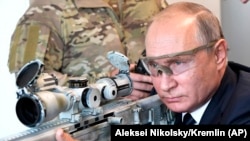Speaking to the State Duma, the lower house of Russia’s parliament, on April 17, Prime Minister Dmitry Medvedev said the international sanctions imposed on Moscow beginning in 2012 had no negative effect on the country’s arms trade. He claimed Russia’s military exports totaled $54.5 billion and went to more than 100 countries.
Medvedev is correct in stating that the arms industry is the sector of the Russian economy least affected by sanctions, including the U.S. restrictions targeting Russia's Defense industry and EU arms embargo imposed in 2014.
Russia remains second largest seller of arms globally, with a 21 percent share of the international market, behind the United States.
Russia’s arms exports apparently benefited from a horrific act --the downing of Malaysia Airlines Flight 17 (MH17) in July 2014, which killed all 298 civilians aboard the jetliner. The Joint Investigation Team said Russia was responsible, and identified the Russian Buk missile, and the Russian military unit to which the individual missile was assigned.
In the years following the 2014 downing, the maker of the Russian Buk TELAR surface-to-air missile, enjoyed a boost in global sales. A Defense News ranking in 2018 found the maker of the missile, JSC Almaz-Antey, scored a 39% increase from $6.58 billion in 2016 to $9.1 billion in 2018.
Still, the numbers cited by Medvedev are not verifiable independently.
The $ 54.5 billion, Medvedev cited as the value of Russia’s military exports -- is not confirmed by independent sources.
According to the Stockholm International Peace Research Institute (SIPRI), in 2017 Russia became the world’s second largest seller of arms. According to SIPRI, the arms sales of the 10 Russian companies listed in its Top 100 reached $37.7 billion that year, an increase of 8.5%. That figure represented the total of both exports and domestic sales.
SIPRI’s data show that Russia’s arms exports fell 17% in the 2014-18 period, with a reduction in arms imports by India and Venezuela the major factor in the decline.
“Russian arms exports to India fell by 42% between 2014–18 and 2009–13. Arms exports to Venezuela, which was the fifth largest recipient of Russian arms in 2009–13, decreased by 96% between the two periods,” SIPRI said.
In 2014–18, Russia delivered major arms to 48 countries (as opposed to the 100 claimed by Medvedev), with 55% of its arms exports sold to its three main recipients -- India, China and Algeria.
One region where Russian exports of major arms are steadily increasing is the Middle East – by 19% as measured in two periods, 2009–13 to 2014–18. In 2014–18, Egypt and Iraq were the main recipients of Russian arms exports to the Middle East -- accounting, respectively, for 46% and 36% of Russian arms exports to the region. Deliveries to Iraq increased by 780% between 2009–13 and 2014–18, while those to Egypt rose by 150%.
Russia’s involvement in illicit global arms trafficking remains a grey area. According to one estimate, the number of stolen weapons in Russia is growing by 10% annually, and some $380 million in illicit weapons exports took place in the early 2000s.









